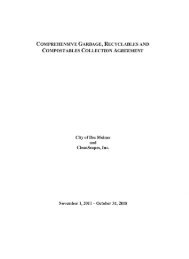CITY OF DES MOINES SHORELINE MASTER PROGRAM
CITY OF DES MOINES SHORELINE MASTER PROGRAM
CITY OF DES MOINES SHORELINE MASTER PROGRAM
You also want an ePaper? Increase the reach of your titles
YUMPU automatically turns print PDFs into web optimized ePapers that Google loves.
Des Moines Shoreline Master Program<br />
because of any combination of bedrock, soil, slope (gradient), slope aspect, structure, hydrology,<br />
or other factors. Examples of these may include, but are not limited to, the following:<br />
1. Areas of historic failures, such as:<br />
a. Those areas delineated by the U.S. Department of Agriculture’s Natural Resources<br />
Conservation Service as having a “severe” limitation for building site development;<br />
b. Those areas mapped by the Washington State Department of Ecology (Coastal Zone<br />
Atlas) or the Washington State Department of Natural Resources (slope stability<br />
mapping) as unstable (U or class 3), unstable old slides (UOS or class 4), or unstable<br />
recent slides (URS or class 5); or<br />
c. Areas designated as quaternary slumps, earthflows, mudflows, lahars, or landslides on<br />
maps published by the U.S. Geological Survey or Washington State Department of<br />
Natural Resources;<br />
2. Any area with a combination of:<br />
a. Slopes greater than 15 percent;<br />
b. Impermeable soils (usually silt and clay) frequently interbedded with granular<br />
permeable soils (usually sand and gravel); and<br />
c. Springs or ground water seepage.<br />
3. Any area which has shown movement during the Holocene epoch (from 10,000 years ago<br />
to present) or which is underlain by mass wastage debris of that age.<br />
4. Any area potentially unstable as a result of rapid stream incision, stream bank erosion, or<br />
undercutting by wave action.<br />
5. Any area designated as Class III landslide hazard area by the “Map Showing Relative<br />
Slope Stability in Part of West-Central King County, Washington, Map I-852-A, U.S.,<br />
Geological Survey Miscellaneous Geologic Investigations” as presently constituted or as<br />
may be subsequently amended;<br />
6. Slopes that are parallel or subparallel to planes of weakness (such as bedding planes, joint<br />
systems, and fault planes) in subsurface materials;<br />
7. Slopes having gradients steeper than 80 percent subject to rock fall during seismic<br />
shaking;<br />
8. Areas located in a canyon or on an active alluvial fan, presently or potentially subject to<br />
inundation by debris flows or catastrophic flooding; and<br />
9. Any area with a slope of 40 percent or steeper and with a vertical relief of 10 or more feet<br />
except areas composed of consolidated rock. A slope is delineated by establishing its toe<br />
and top and is measured by averaging the inclination over at least 10 feet of vertical<br />
relief.<br />
Large-scale 2 . The construction of four (4) dwelling units or more, construction of four thousand<br />
(4,000) square feet of commercial space, or other “actions” as defined by WAC 197-11, State<br />
Environmental Policy Act Rules.<br />
Littoral drift 2 . Sediments moved in an indefinite zone extending from the shoreline to just<br />
beyond the breaker zone by waves and currents.<br />
KEY: 1. RCW or WAC 2. 1988 SMP Glossary 3. City Zoning Code 4. New Definition<br />
Department of Ecology approval effective November 1, 2010<br />
Adopted by City of Des Moines Ordinance No. 1502 123



